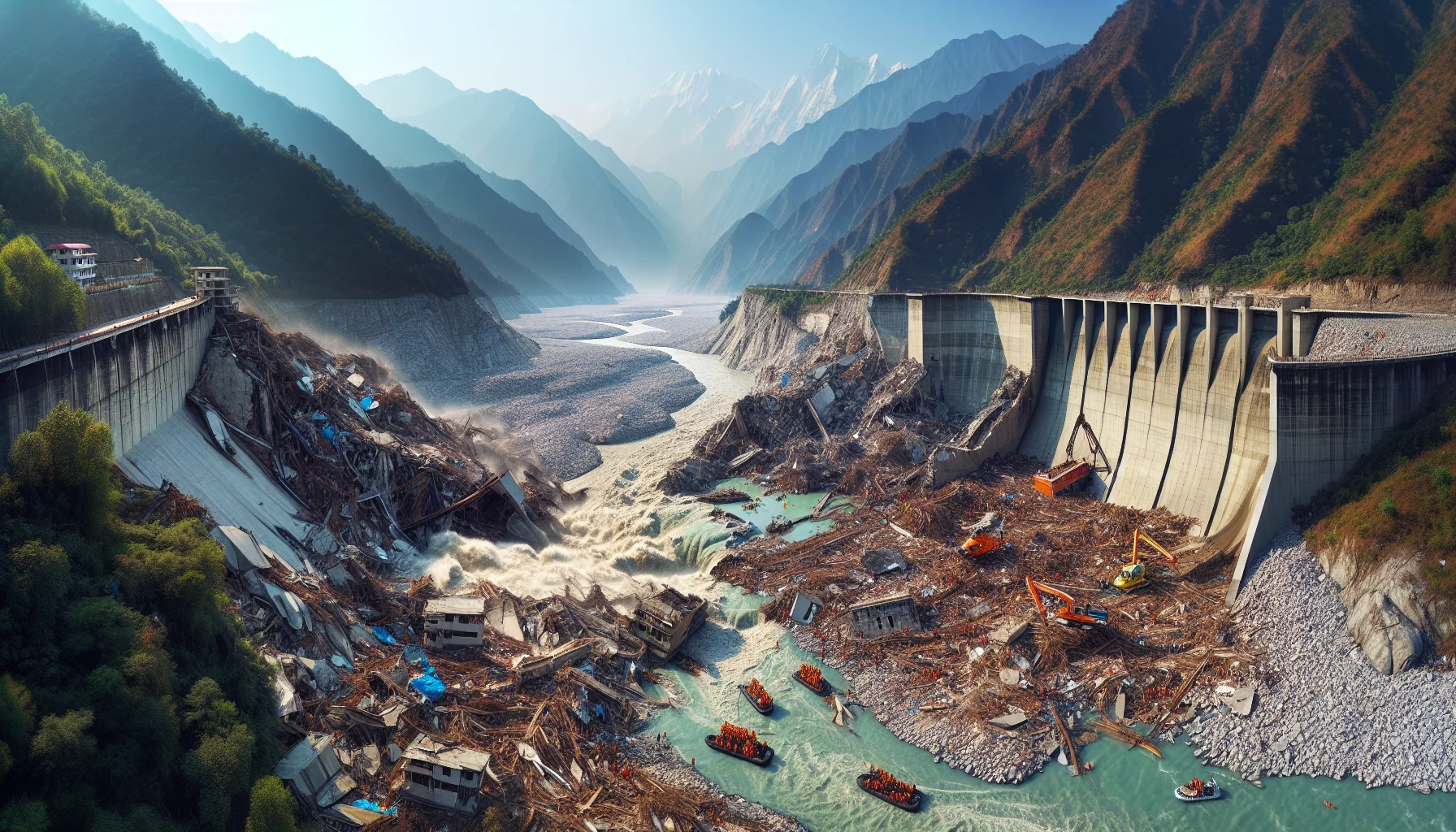
2021 Uttarakhand Flood
by: The Calamity Calendar Team
February 7, 2021
In the serene heights of the Himalayas, nestled within the Indian state of Uttarakhand, a disaster was waiting to unfold. Known for its breathtaking landscapes, the Chamoli district bore witness to a sudden, violent act of nature on the morning of February 7, 2021. What began as a typical winter day quickly spiraled into chaos as a confluence of environmental factors triggered one of the most destructive natural calamities to hit the region in recent memory.
The Fragile Beauty of Chamoli
The Chamoli district, with its picturesque mountains and sacred rivers, is a jewel of Uttarakhand. It's a place where the tranquility of nature is both a blessing and a caution. For years, experts had expressed concerns about the fragile Himalayan terrain, which is particularly prone to landslides, earthquakes, and other natural phenomena. Adding to this vulnerability was the rapid pace of development, with numerous hydropower projects sprouting along its riverbanks. These interventions aimed to harness the power of nature, but they also unwittingly contributed to its volatility.
Before the 2021 disaster, the region had experienced repeated warnings from environmentalists. The interplay of extensive construction and the temperamental natural landscape created a delicate balance, one that was constantly at risk of tipping over. Despite these warnings, numerous projects continued unabated, with little regard for their long-term impact.
Sudden Devastation Strikes
The calamity unfolded in the early hours of February 7th. At about 10:45 AM local time, an enormous rock and ice avalanche set off a chain reaction, resulting in the collapse of a glacial mass near Nanda Devi National Park. The aftermath was swift and brutal—a wall of water barreled down the Rishiganga River, morphing into a monstrous flash flood that hurtled towards the unsuspecting valley below.
Initially, the Rishiganga Hydroelectric Project was the first casualty. The rapid torrent decimated the infrastructure, transforming carefully engineered installations into mere rubble. The force of the flood had only begun as it surged downstream, reaching the Dhauliganga Dam near the village of Raini. There, too, it scored a direct hit, overwhelming the barriers that stood in its way, before continuing its destructive path across the basin.
Rescue Efforts in the Wake of Disaster
In the immediate aftermath, chaos reigned. Panic-stricken residents fled to safety, while others remained trapped in an escalating fight for survival. It was amidst this dire situation that the national and state disaster response teams swung into action. As the floodwaters surged onwards, their mission was clear: to save as many lives as possible.
Thanks for subscribing!
Within hours, over 2,500 personnel were mobilized, deploying helicopters and critical rescue equipment to the hardest-hit areas. They faced a formidable challenge in the rugged terrain, as damaged roads and destroyed bridges impeded access to stranded communities. Yet, their resolve was unwavering. As helicopters hovered above the ruins, rescuers trudged through mud and debris to pull survivors from the wreckage, delivering food and vital supplies to those marooned by the flood.
The Human and Economic Toll
The flood exacted a heavy toll on Chamoli. Nearly 200 lives were lost in the catastrophe, their loved ones left to grapple with the abrupt absence that the tragedy had wrought. Many more were reported missing, their fates uncertain amid the vast destruction that stretched for miles. The numbers continued to climb as rescue operations advanced, painting a grim picture of widespread human suffering.
Economically, the impact was no less severe. The hydropower projects, particularly the Rishiganga small project with a capacity of 13.2 megawatts and the larger Tapovan Vishnugad with 520 megawatts, were rendered defunct. The financial investments, once seen as a step towards renewable energy, now lay washed out, symbolizing the double-edged nature of development in disaster-prone regions.
Beyond the projects, vital infrastructure was obliterated—bridges collapsed, roads were carved from existence, and homes were swept away. For local communities, daily life was upended, with challenges extending from lost livelihoods to a daunting journey through recovery and rehabilitation.
A Call for Change
As the floodwaters receded, leaving behind scars on the land and memory, a chorus of voices emerged, demanding change. The disaster underlined the urgent need for reassessment of industrial activities in ecologically sensitive areas. The multiplication of extended climate change phenomena underscored the necessity for climate-resilient planning and the deployment of robust early warning systems to guard against future calamities.
Experts underscored that while the precise cause of the glacial collapse remained under study, the conditions precipitating it were unfailingly clear. Rapid glacial melting prompted by rising temperatures, paired with the stress exerted by construction activities, formed a perilous dial that could no longer be ignored.
In the corridors of government and civil society, discussions took on renewed vigor. Policies were reconsidered, and calls escalated for coherent strategies merging sustainable development with stringent environmental safeguards. Uttarakhand faced not just the prospect of rebuilding what was lost but redefining how it would coexist with its commanding but temperamental natural environment.
Pathways to Resilience
Since those fateful days in February, the people of Chamoli and Uttarakhand at large have embarked on the road to recovery. With concerted international support and national effort, infrastructure is being painstakingly rebuilt. New priorities include not only restoring image and economy but securing a future where human expansion does not come at nature's expense.
The 2021 Uttarakhand flood stands as a somber reminder of the delicate dance between advancement and nature's unpredictable power. In its aftermath, hope persists that lessons will translate into action, ensuring that such devastation marks not a recurring chapter, but an impetus for enduring change.
Stay in the Loop!
Become a Calamity Insider and get exclusive Calamity Calendar updates delivered straight to your inbox.
Thanks! You're now subscribed.